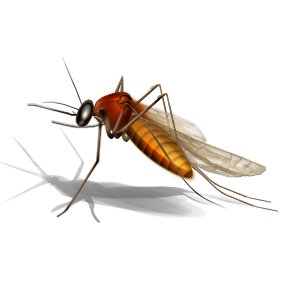The Most-Traveled Cane Toad
Anuran Populations
Questions answered (and bookmarked) on this page:
Are cane toad populations stable?
Controlling toad populations.
Cane toad in my yard!
What about other anurans?
How can I help?
 Is the
population of cane toads stable?
Unlike many
Anurans (and
Bufo in
particular), the cane
toad population is stable. The Australian
population is 10 times greater than that of
Is the
population of cane toads stable?
Unlike many
Anurans (and
Bufo in
particular), the cane
toad population is stable. The Australian
population is 10 times greater than that of
What attempts have been made to control exotic cane toads? Governments have tried chemical, biological, and physical means of controlling cane toads. The difficulties are not only cost and species selectivity, but also efficacy. When one female cane toad can lay upwards of 30,000 eggs, humans are unlikely to effect a long term population control of cane toads if even a few individuals remain.
Chemicals which alter reproductive capacity or result in death are likely to lack species specificity and thus affect other species.
 Biological means, such as introducing a
natural predator, have the same potential disaster as did the
introduction of a cane toad: the introduction of an exotic has
unknown ramifications for any ecosystem.
Biological means, such as introducing a
natural predator, have the same potential disaster as did the
introduction of a cane toad: the introduction of an exotic has
unknown ramifications for any ecosystem.
Some work has been done to sterilize males and then release them back into the environment. Any females who then mate with such a male would then fail to successfully reproduce. However, such efforts are all costly and ineffective, especially over large regions. Additionally, cane toads are resistant to the effects of UV radiation, which in most species would result in male sterility.
 The use of
pheremones is perhaps the most promising option.
Pheremones are scents, both attractant and repellant,
that influence an animal’s behavior. Repellants could be used to dissuade cane toads from entering
new areas. Attractants could be used to
concentrate the toads so that collection or extermination might
be more feasible.
The use of
pheremones is perhaps the most promising option.
Pheremones are scents, both attractant and repellant,
that influence an animal’s behavior. Repellants could be used to dissuade cane toads from entering
new areas. Attractants could be used to
concentrate the toads so that collection or extermination might
be more feasible.

Other work has focused on introducing a host-specific disease or parasite that might wipe out cane toads, but again the unknown risk to other species exists. Minomya elegans, a mosquito which feeds on cane toads, may be used as a vector for such parasites.
Physical means have also
been attempted. Barriers such as fences that allow
only animals smaller than cane toads to pass through have been
used with some success on small scale projects, such as the
protection of a single pond. Barriers are
only about 18 inches tall, enabling most critters to be
unaffected by the barrier.
Some state and
local governments within
One problem common to all the attempted methods of toad control is the need for lots of funding. Nothing is cheap when the affected regions are so large! Piece-wise programs are sometimes all that's available.
If a cane toad is in your yard, the Australian government urges residents to first remove pets and small children from the area. Toads can be picked up (preferably with gloves) and placed in a container or bag for humane transport to a toad identification center, where they will be positively identified as cane toads and then humanely euthanized. The government expresses concern that residents may kill native frogs which they incorrectly identify cane toad. Furthermore, all animals – exotic and pesky or not – deserve humane deaths.
 Why are other frogs
on the decline?
Why are other frogs
on the decline?
-Lifecycle-Because frogs live both in water and on land during their lifecycles, changes in either environment influence them. The developmental stage is very vulnerable.
 -Skin permeability- Amphibian skin is
permeable to both gas and liquid, both during time spend in
water and on land, and so the skin can absorb toxins all the
time. When frogs get really dehydrated, their
skin is even less selective on what it absorbs.
-Skin permeability- Amphibian skin is
permeable to both gas and liquid, both during time spend in
water and on land, and so the skin can absorb toxins all the
time. When frogs get really dehydrated, their
skin is even less selective on what it absorbs.
-UV exposure- Amphibians are greatly
influenced by CFCs. While CFCs are now mostly
banned, they are still used in some products
and in some parts of
th e world. Ozone depletion enables greater UV
penetration, which is very hazardous to amphibians during the
lifecycle. Frogs can and do get skin cancer. Pigments in both frog
skin and in frog eggs partially protect against UV radiation, as
does their behaviors. However,
frogs attempt thermoregulation by basking in
sunlight (especially at high
elevations or in colder climates),
and UV exposure is a
considerable problem.
e world. Ozone depletion enables greater UV
penetration, which is very hazardous to amphibians during the
lifecycle. Frogs can and do get skin cancer. Pigments in both frog
skin and in frog eggs partially protect against UV radiation, as
does their behaviors. However,
frogs attempt thermoregulation by basking in
sunlight (especially at high
elevations or in colder climates),
and UV exposure is a
considerable problem.
 -Feeding habits-Collectively,
frog feeding habits are like eating out of the trashcan -- they
get both the good scraps and a lot of bad. Tadpoles are exposed to
toxins both by gill respiration and by feeding.
They filter-feed on algae and plant particulates, both at
the water surface and in the detritus at the bottom of the pond.
Oily substances congregate on top of the water, meaning
that surfacing tadpoles are exposed to oil-soluble toxins as
well as the water-soluble toxins through which they swim.
Chlorinated chemicals persist by adhering to sediments on
the bottom of the pond. Fat-soluble toxins
can remain in the frog body for life. As
adults, frogs are exposed to contaminants on land and on the
water surface, in the water, and in the pond bottom when they
dive into water. Adults also experience
biomagnifications of toxins; they eat insects and other pests
which may be contaminated with pesticides and herbicides.
-Feeding habits-Collectively,
frog feeding habits are like eating out of the trashcan -- they
get both the good scraps and a lot of bad. Tadpoles are exposed to
toxins both by gill respiration and by feeding.
They filter-feed on algae and plant particulates, both at
the water surface and in the detritus at the bottom of the pond.
Oily substances congregate on top of the water, meaning
that surfacing tadpoles are exposed to oil-soluble toxins as
well as the water-soluble toxins through which they swim.
Chlorinated chemicals persist by adhering to sediments on
the bottom of the pond. Fat-soluble toxins
can remain in the frog body for life. As
adults, frogs are exposed to contaminants on land and on the
water surface, in the water, and in the pond bottom when they
dive into water. Adults also experience
biomagnifications of toxins; they eat insects and other pests
which may be contaminated with pesticides and herbicides.
-Habitat destruction-When humans
fractionate habitat, populations are isolated from each other
and genetic diversity may decrease, making frogs more
susceptible to pathogens or generally less successful in
breeding. Due to physiological constraints
such as the need for water, frogs cannot easily migrate across a
city or road to reach the rest of their population.
-Climatic swings-Changes in temperature and
seasons influence the breeding habits and speed of maturation
for tadpoles. If the young do not
metamorphosize before ponds evaporate, freeze over, or overheat, the next generation of frogs will be much smaller.
the next generation of frogs will be much smaller.
-Metamorphosis-Hormones drive the process of metamorphosis. Hormone mimics and disruptors may therefore destroy the maturation process. The process of metamorphosis itself is fraught with difficulties, as metamorphosizing frogs aren’t as agile or able to cope with changing conditions as are adult frogs. As tadpoles essentially go through puberty, they are clumsy and less able to catch food. They thus rely on fat stores for energy, but in the process of metabolizing fat also re-circulate toxins that were stored in that fat.
 -Reproduction-Male calling and female egg
production is a huge energy demand, at a time when frogs are
sitting by the ponds or mating instead of hunting for food.
They are forced to rely upon fat stores for energy, but
in the process release and recirculate fat-soluble toxins.
Starving females may also resorb their eggs, which again
re-circulates toxins.
-Reproduction-Male calling and female egg
production is a huge energy demand, at a time when frogs are
sitting by the ponds or mating instead of hunting for food.
They are forced to rely upon fat stores for energy, but
in the process release and recirculate fat-soluble toxins.
Starving females may also resorb their eggs, which again
re-circulates toxins.
What human activties harm frogs? How can I help declining frogs? You can help frogs by using less chemical fertilizer and pesticide, not trampling or otherwise destroying their habitat (eg, by taking souvenirs), by properly disposing of wastes, and driving slowly through frog habitats – especially during breeding season. Do not release any pet frogs into the wild, as exotics such as cane toads alter ecosystems. Promote forest and habitat preservation. Do not buy wild-caught frogs from the pet trade. Support healthy mining practices, as mining often releases gluts of heavy metals, which are toxic to life. Do not eat frog species whose populations are in jeopardy, and if you do eat frog legs or eggs, be responsible and aware of how such foods were acquired.
Now that you understand a bit of the world crisis for frogs, and the story comes to an unhappy ending, learn my opinion on it! Go to About me (and my opinions) next.